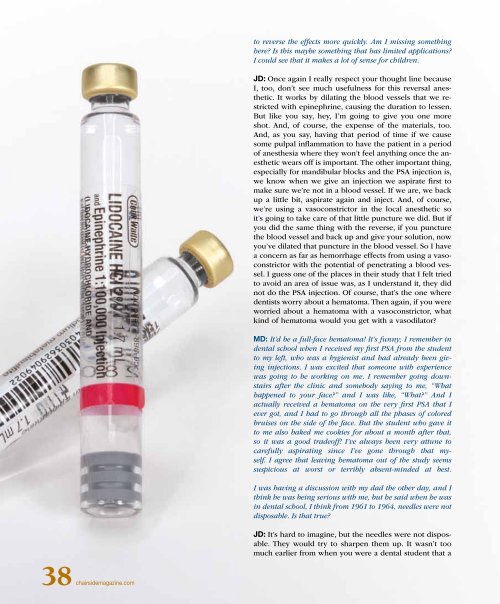PDF Version - Glidewell Dental Labs
PDF Version - Glidewell Dental Labs
PDF Version - Glidewell Dental Labs
You also want an ePaper? Increase the reach of your titles
YUMPU automatically turns print PDFs into web optimized ePapers that Google loves.
to reverse the effects more quickly. Am I missing something<br />
here? Is this maybe something that has limited applications?<br />
I could see that it makes a lot of sense for children.<br />
JD: Once again I really respect your thought line because<br />
I, too, don’t see much usefulness for this reversal anesthetic.<br />
It works by dilating the blood vessels that we restricted<br />
with epinephrine, causing the duration to lessen.<br />
But like you say, hey, I’m going to give you one more<br />
shot. And, of course, the expense of the materials, too.<br />
And, as you say, having that period of time if we cause<br />
some pulpal inflammation to have the patient in a period<br />
of anesthesia where they won’t feel anything once the anesthetic<br />
wears off is important. The other important thing,<br />
especially for mandibular blocks and the PSA injection is,<br />
we know when we give an injection we aspirate first to<br />
make sure we’re not in a blood vessel. If we are, we back<br />
up a little bit, aspirate again and inject. And, of course,<br />
we’re using a vasoconstrictor in the local anesthetic so<br />
it’s going to take care of that little puncture we did. But if<br />
you did the same thing with the reverse, if you puncture<br />
the blood vessel and back up and give your solution, now<br />
you’ve dilated that puncture in the blood vessel. So I have<br />
a concern as far as hemorrhage effects from using a vasoconstrictor<br />
with the potential of penetrating a blood vessel.<br />
I guess one of the places in their study that I felt tried<br />
to avoid an area of issue was, as I understand it, they did<br />
not do the PSA injection. Of course, that’s the one where<br />
dentists worry about a hematoma. Then again, if you were<br />
worried about a hematoma with a vasoconstrictor, what<br />
kind of hematoma would you get with a vasodilator?<br />
MD: It’d be a full-face hematoma! It’s funny; I remember in<br />
dental school when I received my first PSA from the student<br />
to my left, who was a hygienist and had already been giving<br />
injections. I was excited that someone with experience<br />
was going to be working on me. I remember going downstairs<br />
after the clinic and somebody saying to me, “What<br />
happened to your face?” and I was like, “What?” And I<br />
actually received a hematoma on the very first PSA that I<br />
ever got, and I had to go through all the phases of colored<br />
bruises on the side of the face. But the student who gave it<br />
to me also baked me cookies for about a month after that,<br />
so it was a good tradeoff! I’ve always been very attune to<br />
carefully aspirating since I’ve gone through that myself.<br />
I agree that leaving hematoma out of the study seems<br />
suspicious at worst or terribly absent-minded at best.<br />
I was having a discussion with my dad the other day, and I<br />
think he was being serious with me, but he said when he was<br />
in dental school, I think from 1961 to 1964, needles were not<br />
disposable. Is that true?<br />
JD: It’s hard to imagine, but the needles were not disposable.<br />
They would try to sharpen them up. It wasn’t too<br />
much earlier from when you were a dental student that a<br />
38 chairsidemagazine.com

















